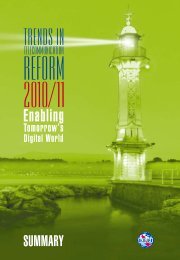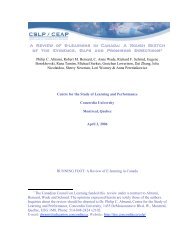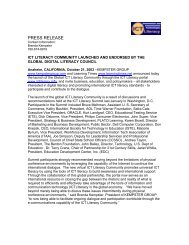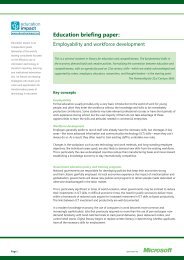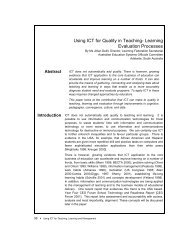147 pages pdf - ICT Digital Literacy
147 pages pdf - ICT Digital Literacy
147 pages pdf - ICT Digital Literacy
You also want an ePaper? Increase the reach of your titles
YUMPU automatically turns print PDFs into web optimized ePapers that Google loves.
Pedagogy & Webagogy -- Ready, Set … TRAIN and FACILITATE!<br />
#587: Make Up For The Difference<br />
Connect with the virtual learner and compensate for lack of face-to-face contact by: Sending a<br />
confirmation when the registration is received and a day before the session; Using pictures<br />
(yours and theirs); Greeting the learner when he/she signs-on and welcoming each learner with<br />
an easy/involving activity; Sending a brief pre-course assignment and information about the<br />
course and yourself; Planning questions and interaction ahead of time; Using posts, emails<br />
before and after the class; Having a summary activity; Sending congratulations for completing<br />
the class.<br />
Jean Barbazette<br />
The Training Clinic<br />
#588: Make It Personal<br />
If at all possible, e-Learning should be as personal as a classroom setting. Consider having a<br />
hands-on learning portion taught via e-Learning and then classroom instruction for interaction<br />
and the "personal touch."<br />
Dori Ottaviano<br />
#589: Examples You Can Relate To<br />
Blend in scenarios or examples that relate to the company and the way it operates to help the<br />
student convert the knowledge to practice. This may have to be an addendum delivered in a live<br />
analog or virtual classroom.<br />
Paul L. Nenninger<br />
PLN Consulting<br />
#590: Never Assume<br />
Instructor Led courses have the benefit of an instructor making real-time adaptations according<br />
to audience needs. Online classes have to fit more into less time and offer less flexibility so try<br />
not to make assumptions as to audience's abilities and relevance. As I was once told, ASSUME<br />
makes an ASS out of U and ME!<br />
Martin Cannard<br />
Symantec Corporation<br />
#591: More Ways, More Learning<br />
Ensure there are lots of ways for your learners to learn. Plan many modes of interaction among<br />
your learners - not just the more obvious reading of text and test taking.<br />
Mary Anne Campo<br />
#592: How To Make It Into The Agendas Of Your Learners<br />
During a course, arrange for synchronous events on a regular basis. In addition to the opportunity of being<br />
in contact with your learners, this structure will force the participants to add the events to their calendars<br />
and so the 'learning' is going to be part of their plans for the week/day.<br />
Urs Frei<br />
Teachforce Urs Frei GmbH<br />
#593: Use Virtual Tools For Troubleshooting<br />
When teaching someone how to use a custom computer application via the (Intranet/Internet,<br />
consider using a virtual classroom & collaboration platform so you can see if what the user is<br />
actually doing is what they are telling you they are doing. Many times learners leave out a vital<br />
keystroke or are even on a different screen than the trainer.<br />
Dailia Adams<br />
International Comfort Products<br />
#594: Goal: Learn By Doing<br />
701 e-Learning Tips by The MASIE Center www.masie.com 117






